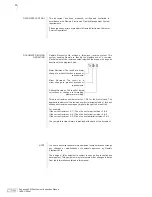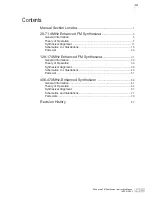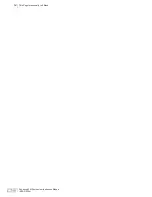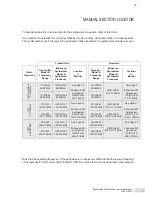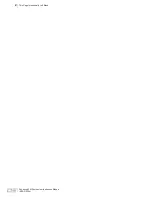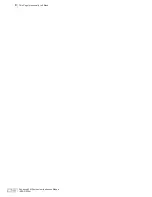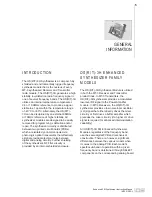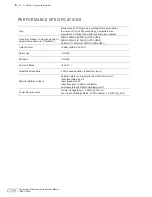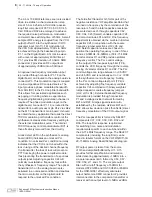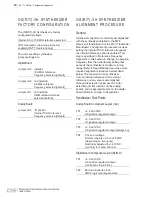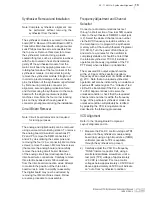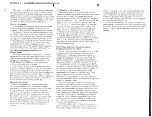
Enhanced FM Synthesizer Instruction Manual
IM10-OS3AH
7
THEORY
OF OPERATION
THEORY OF OPERATION
Internal Power and Control (Digital Board)
The synthesizer operates from a +9.5VDC
power source applied to connector pin P1-2.
Total current draw is approximately 160mA.
POWER DOWN control line P2-4 controls
the +5.0VDC microcontroller regulator U2
through power MOSFET switch U1. For
receiver applications the synthesizer is
always ON, with the enable line P2-4 directly
connected to +9.5VDC. For transmitter
applications, pin P2-4 is controlled by the
MT-3 Transmitter Board jumper J18 which
selects the synthesizer standby mode. In
Low Current Standby Mode, less than 14mA
is drawn, however, a delay of approximately
50ms from PTT activation to transmitter turn
on is then required to allow for the synthesizer
to lock. In Normal Mode, with the synthesizer
ON continuously, less than 10ms delay is
encountered. This capability comes at the
expense of additional standby current (160mA).
Synthesizer Analog Circuitry (Analog Board)
The Analog Board utilizes four optical receivers
(U1–U4) and one optical transmitter (U5)
to provide an isolated data interface to the
digital board. The regulator IC U8 provides
a cont5.0VDC to the internal TCXO
and power control optical receiver U1 when
ever +9.5VDC is applied to the synthesizer’s
voltage terminals. The analog board’s main
power is turned on and off by driving the optical
receiver U1. U1 is driven by U4 on the digital
board, which is controlled by the microcontroller.
The main power regulators are provided by
U6 and U7. Regulator U6 provides switched
+8.0VDC and regulator U7 proves switched
+5.0VDC. The power MOSFET IC U9 works
as a clamping circuit to quickly discharge the
VCO fi lter capacitors C32 and C33; when
U9 is powered down the RF output from the
VCO is suppressed almost immediately.
At the heart of the OS(R/T)-3H Enhanced
Synthesizer is U10 a low power, single chip
PLL synthesizer IC. U10 is setup to use a 9.6
or 10.0MHz reference signal provided either
from the internal TCXO (with JU1-B selected)
or from the external SMB connector J1 (with
JU1-A selected). The reference signal’s
frequency is selected by jumper JU2 on the
digital board; 9.6MHz is selected if JU2 is
not installed and 10MHz if JU2 is installed. If
an external reference signal is used it must
be sinusoidal, low phase noise, and highly
stable with an output power of 0dBm ±3dBm.
A poor quality reference source will degrade
the receiver or transmitter performance to
unacceptable levels. The external reference
is buffered by transistor Q2 on the analog
board, which has 50Ω input impedance at
10.0MHz. The internal TCXO reference of
10.0MHz provides better than ±1ppm frequency
stability from -30°C to +60°C (-40°C to +60°C
optional). The TCXO fi ne frequency adjustment
is made through potentiometer RV1, which is
accessible through the synthesizer’s top cover.
Summary of Contents for OSR-3H061
Page 4: ...Enhanced FM Synthesizer Instruction Manual IM10 OS3AH iv This Page Intentionally Left Blank...
Page 6: ...Enhanced FM Synthesizer Instruction Manual IM10 OS3AH 2 This Page Intentionally Left Blank...
Page 8: ...Enhanced FM Synthesizer Instruction Manual IM10 OS3AH 4 This Page Intentionally Left Blank...
Page 26: ...Enhanced FM Synthesizer Instruction Manual IM10 OS3AH 22 This Page Intentionally Left Blank...
Page 36: ...Enhanced FM Synthesizer Instruction Manual IM10 OS3AH 32 This Page Intentionally Left Blank...
Page 54: ...Enhanced FM Synthesizer Instruction Manual IM10 OS3AH 50 This Page Intentionally Left Blank...
Page 64: ...Enhanced FM Synthesizer Instruction Manual IM10 OS3AH 60 This Page Intentionally Left Blank...
Page 82: ...Enhanced FM Synthesizer Instruction Manual IM10 OS3AH 78 This Page Intentionally Left Blank...
Page 94: ...Enhanced FM Synthesizer Instruction Manual IM10 OS3AH 90 This Page Intentionally Left Blank...


